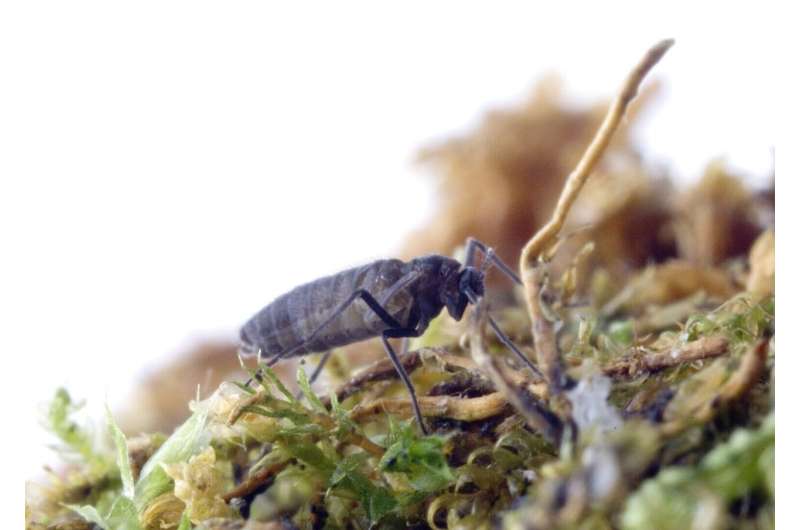The midge is originally a native of South Georgia before arriving in Signy. Credit: Pete Bucktrout – BAS
A tiny flightless midge that has colonized Antarctica's Signy Island is driving fundamental changes to the island's soil ecosystem.
Research by experts at the British Antarctic Survey (BAS) in collaboration with the University of Birmingham has revealed that a non-native midge species is significantly increasing rates of plant decomposition, resulting in three to five-fold increases in soil nitrate levels compared to sites where only native invertebrates occur.
The study, published in the journal Soil Biology and Biochemistry, was part of a Ph.D. project completed by Dr. Jesamine Bartlett jointly between Birmingham and BAS, and outlines how the midge, Eretmoptera murphyi, is altering soil ecosystems on the island. The insect is a decomposer, feeding on dead organic matter across the island which releases large amounts of nutrients into the soil.
Dr. Bartlett, lead author of the study, says, "Antarctic soils are very nutrient limited systems because decomposition rates are so slow. The nutrients are there, but it has taken this invasive midge to unlock them on Signy Island. It is an 'ecosystem engineer' in a similar way to earthworms in temperate soil systems."
Eretmoptera murphyi, is a native of South Georgia—an island in the sub-Antarctic region. It was introduced to Signy Island by accident during a botany experiment in the 1960s, although its proliferation only became apparent during the 1980s. Prior to this, the only terrestrial sites on Signy with high nutrient levels were those associated with marine species coming ashore, for example penguin colonies and seal wallows.
The level of nitrates measured in soil colonized by Eretmoptera was comparable to that found close to seal wallows, despite the midge being only a few millimeters in size. This is because population densities of midge larvae can reach in excess of 20,000 individuals per m2 at some sites.
Spread by humans, mostly by hitching a ride on the soles of boots of researchers and tourists, the midge has gradually expanded the area it has colonized on the island. It can even survive in sea water for periods of time, leading to conjecture that it could eventually reach other islands.
Professor Peter Convey, a terrestrial ecologist at BAS, says, "A particular feature of the Antarctic is that it has had very few invading species so far and protecting this ecosystem is a very high priority. While at some level, there's plenty of awareness of the implications of invading species, this research really highlights how the tiniest of animals can still have a hugely significant impact."
The hostile Antarctic environment is a huge barrier to these invading species with very low temperatures, moisture, and nutrient availability. Alongside rising temperatures in the region, the nutrients released by the midges will start to allow more of these invaders.
Dr. Scott Hayward, an ecologist at the University of Birmingham and co-author, says, "The activity of the midges on Signy, in combination with climate change, potentially 'opens the door' for other species to become established which can further accelerate climate change. The midge has the capacity to survive in many Antarctic locations, so monitoring the spread and impacts on Signy is vital for our understanding of other Antarctic ecosystems."
More information: Jesamine C. Bartlett et al, Ecological consequences of a single introduced species to the Antarctic: terrestrial impacts of the invasive midge Eretmoptera murphyi on Signy Island, Soil Biology and Biochemistry (2023). DOI: 10.1016/j.soilbio.2023.108965
Provided by British Antarctic Survey
























